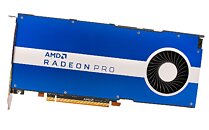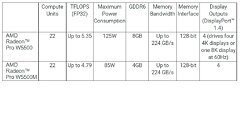- Joined
- Oct 9, 2007
- Messages
- 47,857 (7.38/day)
- Location
- Dublin, Ireland
| System Name | RBMK-1000 |
|---|---|
| Processor | AMD Ryzen 7 5700G |
| Motherboard | Gigabyte B550 AORUS Elite V2 |
| Cooling | DeepCool Gammax L240 V2 |
| Memory | 2x 16GB DDR4-3200 |
| Video Card(s) | Galax RTX 4070 Ti EX |
| Storage | Samsung 990 1TB |
| Display(s) | BenQ 1440p 60 Hz 27-inch |
| Case | Corsair Carbide 100R |
| Audio Device(s) | ASUS SupremeFX S1220A |
| Power Supply | Cooler Master MWE Gold 650W |
| Mouse | ASUS ROG Strix Impact |
| Keyboard | Gamdias Hermes E2 |
| Software | Windows 11 Pro |
AMD today announced the AMD Radeon Pro W5500 workstation graphics card, delivering the performance and advanced features demanded by today's Design & Manufacturing and Architecture, Engineering & Construction (AEC) professionals. AMD also announced the AMD Radeon Pro W5500M GPU, designed and optimized to power next-generation, high-performance professional mobile workstations. Today's design and engineering workforce pushes the boundaries of professional design applications. These increasingly mobile professionals often use multiple graphics-intensive applications simultaneously and require no-compromise performance to visualize, review and interact with their designs in real time.
AMD Radeon Pro W5500 graphics harness the high-performance, power-efficient AMD RDNA architecture, 7 nm process technology, high-speed GDDR6 memory, high-bandwidth PCI Express 4.0 support and advanced software features. Expanding the AMD family of high-performance professional graphics products, they offer outstanding performance in real-world applications, rock-solid stability and superb energy efficiency. In addition, the AMD Radeon Pro W5500 graphics card delivers incredible multitasking performance even in demanding situations, such as allowing professionals to continue developing their designs while rendering a visualization in the background.

"Designers and engineers require a professional graphics solution that delivers the performance and efficiency to meet today's unique challenges. Nothing is more stressful than a deadline, and AMD professional graphics keep performing when you need them most," said Scott Herkelman, corporate vice president and general manager, Radeon Technologies Group at AMD. "The AMD Radeon Pro W5500 graphics card delivers exceptional power efficiency and leadership performance for 2D and 3D design applications, enabling them to better visualize and interact with their designs in real time, explore new immersive workflows like virtual reality and maximize productivity."
The AMD Radeon Pro W5500 graphics card and the Radeon Pro W5500M GPU transform how project teams collaborate by enabling immersive, real-time visualizations of design concepts to make quick and better informed decisions. Key capabilities and features include:
The AMD Radeon Pro W5500 graphics card is expected to be available from leading retailers beginning mid-February 2020, for an SEP of $399 USD.

View at TechPowerUp Main Site
AMD Radeon Pro W5500 graphics harness the high-performance, power-efficient AMD RDNA architecture, 7 nm process technology, high-speed GDDR6 memory, high-bandwidth PCI Express 4.0 support and advanced software features. Expanding the AMD family of high-performance professional graphics products, they offer outstanding performance in real-world applications, rock-solid stability and superb energy efficiency. In addition, the AMD Radeon Pro W5500 graphics card delivers incredible multitasking performance even in demanding situations, such as allowing professionals to continue developing their designs while rendering a visualization in the background.

"Designers and engineers require a professional graphics solution that delivers the performance and efficiency to meet today's unique challenges. Nothing is more stressful than a deadline, and AMD professional graphics keep performing when you need them most," said Scott Herkelman, corporate vice president and general manager, Radeon Technologies Group at AMD. "The AMD Radeon Pro W5500 graphics card delivers exceptional power efficiency and leadership performance for 2D and 3D design applications, enabling them to better visualize and interact with their designs in real time, explore new immersive workflows like virtual reality and maximize productivity."
The AMD Radeon Pro W5500 graphics card and the Radeon Pro W5500M GPU transform how project teams collaborate by enabling immersive, real-time visualizations of design concepts to make quick and better informed decisions. Key capabilities and features include:
- High-Performance AMD RDNA Architecture - Features a redesigned geometry engine and compute units, delivering up to 25 percent higher performance-per-clock than the previous-generation Graphics Core Next (GCN) architecture.
- Incredible Multitasking Performance - The AMD Radeon Pro W5500 graphics card delivers outstanding multitasking performance even in demanding situations, offering up to 10x better estimated application workflow performance than the competition in the SPECviewperf 13 benchmark under a multitasking load.
- Real-World Power Efficiency - The combination of the power efficient AMD RDNA architecture and Radeon Pro Software for Enterprise's intelligent power management technology enable the AMD Radeon Pro W5500 graphics card to precisely scale to meet the power demands of professional applications. As a result, it consumes up to 32 percent less system power on average in SOLIDWORKS solid modeling workflows than the competition.
- Professional-Grade Software - Radeon Pro Software for Enterprise offers performance improvements in each release and is optimized for demanding 24/7 computing environments, with extensive OEM platform and ISV certification testing to deliver the quality professionals demand. The latest driver (20.Q1) achieves up to an estimated 15 percent faster geomean score in the SPECviewperf 13 benchmark than version 19.Q1 from 20194.
- AMD Remote Workstation - Allows professionals to access their physical workstations from virtually anywhere with rich graphics experiences using Citrix Virtual Apps and Desktops or Microsoft Remote Desktop.
The AMD Radeon Pro W5500 graphics card is expected to be available from leading retailers beginning mid-February 2020, for an SEP of $399 USD.

View at TechPowerUp Main Site






